
Female
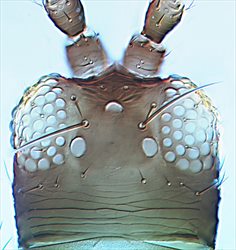
Head
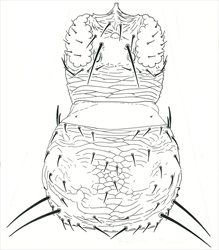
Head & pronotum
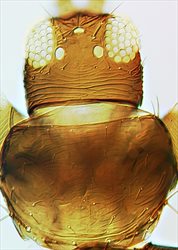
Head & pronotum
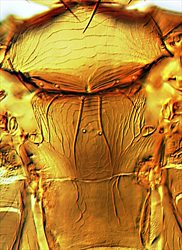
Meso & metanota

Fore tibia & tarsus

Fore wing
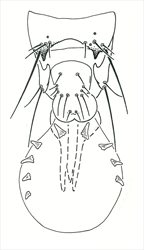
Male tergite IX & genitalia
Both sexes fully winged. Body and legs dark brown, tarsi paler, antennal segment III yellow, IV–VIII brown; fore wings brown with sub-basal white band. Antennae 8-segmented; segments III–IV constricted to apex, each with forked sense cone; segment VI sense cone with enlarged oval base; dorsal apex of segment I with pair of setae. Head wider than long; three pairs of ocellar setae present, pair III as long as distance between compound eyes, arising on or just outside anterior margins of ocellar triangle. Pronotum with two pairs of long posteroangular setae; discal area with sculpture lines but with few setae. Fore tibia apex without claws, but ventrally with small recurved tubercle, and inner margin at apex with a stout seta on a small tubercle. Mesonotum with paired anterior campaniform sensilla, median setae close to posterior margin. Metanotum weakly reticulate; median setae long, arising at anterior margin; campaniform sensilla present. Fore wing first vein with setal row almost complete but with a small sub-apical gap; setal row complete on second vein. Abdominal tergites with no ctenidia, no sculpture medially; tergite VIII with posteromarginal comb broadly interrupted medially, with long slender microtrichia laterally; VIII with group of microtrichia anterolateral to spiracle; IX with 2 pairs of campaniform sensilla, X with long split. Sternites without discal setae, S1 on VII arising in front of margin.
Male smaller than female; tergite IX with pair of small stout setae (tubercles?) posterolaterally; sternites without pore plates; extruded genitalia bearing two rows each of 4 (or 5) stout spines that decrease in size distally.
The genus Odontothrips currently includes 33 species. All but two of these are from the Holarctic region, including Iran and China, but one species is described from Rajasthan, India, and another from Guinea. From Europe, 19 species of Odontothrips are recorded (zur Strassen, 2003), with eight from Britain. Almost all Odontothrips species breed only in the flowers of Fabaceae (Pitkin, 1972). The fore tibial apex of ignobilis is similar to that of loti but with the claw reduced to little more than a curved tubercle. The fore wing colour and setal row on the first vein are also similar to loti, as is the posterior margin of tergite IX in the male, but the male genitalia have two rows of endothecal spines.
Feeding and breeding in flowers and pupating at ground level, and associated with several species in the genera Ulex and Genista [Fabaceae].
In Britain known from Surrey to the Isles of Scilly and north to Cumbria, including west Wales, but yet to be recorded from the north east of England or Scotland (Mound et al., 1976), reflecting the distribution of its primary hosts Ulex gallii and U. minor. Recorded widely across western Europe from Germany to Portugal, as well as Morocco and the Canary Islands.
THRIPIDAE - THRIPINAE
Odontothrips ignobilis Bagnall
Odontothrips ignobilis Bagnall, 1919: 262
Odontothrips mutabilis Bagnall, 1924: 262
Odontothrips inermis Bagnall, 1928: 95
Mound LA, Morison GD, Pitkin BR & Palmer JM (1976) Thysanoptera. Handbooks for the Identification of British Insects 1 (11): 1–79.
Pitkin BR (1972) A revision of the flower-living genus Odontothrips Amyot & Serville. Bulletin of the British Museum (Natural History) (Entomology) 26: 371–402.
zur Strassen R (2003) Die terebranten Thysanopteren Europas und des Mittelmeer-Gebietes. Die Tierwelt Deutschlands 74: 1–271.